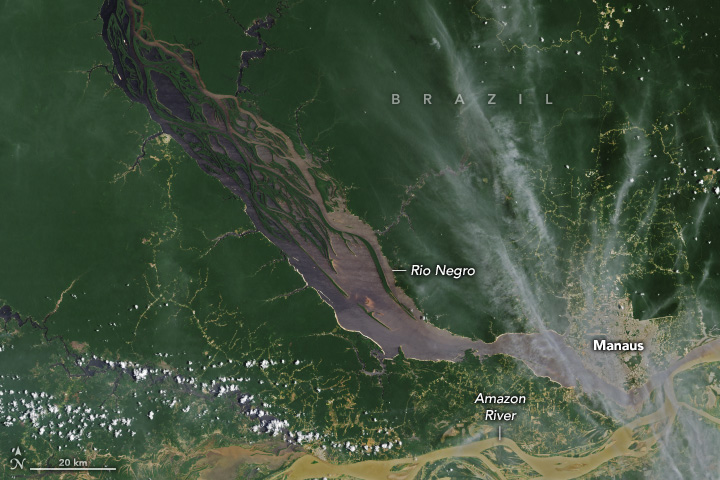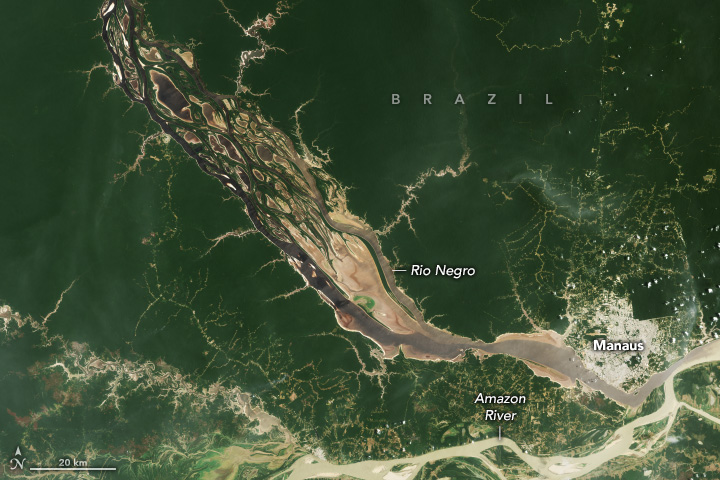

Drought on the Rio Negro
Downloads
- rionegro_oli2_2022281_lrg.jpg (5584x3723, JPEG)
- rionegro_oli_2023276_lrg.jpg (5584x3723, JPEG)
Metadata
- Sensor(s):
- Landsat 9 - OLI-2
- Landsat 8 - OLI
- Data Date: October 8, 2022
- Visualization Date: October 17, 2023
July through October fall within the dry season in the western and northern Amazon rainforest, but a particularly acute lack of rain during this period in 2023 has pushed the region into a severe drought.
The OLI (Operational Land Imager) instrument on Landsat 8 captured this image (right) of the parched Rio Negro in the Brazilian province of Amazonas near the city of Manaus on October 3, 2023. On that date, the level of the river, the largest tributary of the Amazon River, had dropped to 15.14 meters (50.52 feet), according to data collected by the Port of Manaus. For comparison, the image on the left shows the same area on October 8, 2022, when the water level was 19.59 meters, a more typical level for October. Rio Negro water levels continued to drop in the days after the image was collected, reaching a record low of 13.49 meters on October 17, 2023.
Some areas in the Amazon River’s watershed have received less rain between July and September than any year since 1980, Reuters reported. The drought has been particularly severe in the Rio Negro watershed in northern Amazonas, as well as parts of southern Venezuela and southern Colombia.
“Overall, this is a pretty unusual and extreme situation,” said René Garreaud, an atmospheric scientist at the University of Chile. “The primary culprit exacerbating the drought appears to be El Niño.” This cyclical warming of surface waters in the central-eastern Pacific functions somewhat like a boulder in the middle of a stream, disrupting atmospheric circulation patterns in ways that lead to wetter conditions over the equatorial Pacific and drier conditions over the Amazon Basin.
According to news outlets, the low river water levels on the Rio Negro and other nearby rivers have disrupted drinking water supplies in hundreds of communities, slowed commercial navigation, and led to fish and dolphin die-offs.
Manaus, the capital and largest city of the Brazilian state of Amazonas, is the primary transportation hub for the upper Amazon, serving as an important transit point for soap, beef, and animal hides. Other industries with a presence in the city of two million people include chemical, ship, and electrical equipment manufacturing.
References
- Associated Press (2023, October 16) In Brazil’s Amazon, rivers fall to record low levels during drought. Accessed October 17, 2023.
- Centro Nacional de Monitoramento e Alertas de Desastres Naturais (2023, October 16) Monitoring of drought impacts in Brazil — September 2023. Accessed October 17, 2023. ??
- NASA Earthdata Drought. Accessed October 17, 2023.
- NASA Earth Observatory Drought. Accessed October 17, 2023.
- NASA Earth Observatory World of Change: El Niño, La Niña, and Rainfall. Accessed October 17, 2023.
- NOAA (2023, October 17) 90 Day Total Rainfall Anomaly: 18Jul2023 - 150ct2023. Accessed October 17, 2023.
- Porto de Manaus (2023, October 17) Rio Negro River Level. Accessed October 17, 2023.
- Reuters (2023, October 10 ) Amazon’s Indigenous people urge Brazil to declare climate emergency as rivers dry up. Accessed October 17, 2023.
- Serviço Geológico do Brasil (2023, October 16) 42° Boletim de Monitoramento Hidrológico da Bacia do Amazonas. Accessed October 17, 2023.
NASA Earth Observatory images by Wanmei Liang, using Landsat data from the U.S. Geological Survey. Story by Adam Voiland.
This image record originally appeared on the Earth Observatory. Click here to view the full, original record.